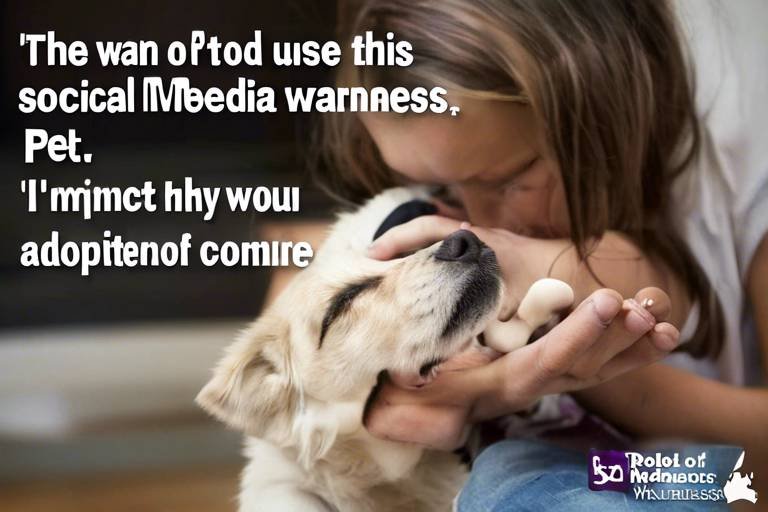The Role of Community in Supporting Animal Rescue
Animal rescue is not just the responsibility of dedicated organizations; it is a collective effort that thrives on the strength of community involvement. When communities come together, they create a powerful network that enhances the effectiveness of animal rescue efforts. Imagine a bustling neighborhood where every resident feels a sense of responsibility towards the welfare of animals in need. This kind of community spirit can transform lives—both for the animals and the people who help them. By fostering collaboration, education, and resource sharing, communities can significantly improve the welfare of animals that are often overlooked.
Community awareness and education play pivotal roles in this equation. It’s crucial for residents to understand the importance of responsible pet ownership and the impact of supporting local rescues. Through workshops, outreach programs, and social media campaigns, communities can raise awareness about the challenges faced by animal shelters and the importance of adopting rather than buying pets. When people are educated about these issues, they are more likely to take action, whether it’s by adopting a pet or volunteering their time and resources.
Volunteer opportunities abound in the realm of animal rescue, and these opportunities are a vital aspect of community support. Individuals can contribute their time and skills in various ways. Some may choose to foster animals, providing them with a temporary home, while others might assist at events or help with administrative tasks. Each contribution, no matter how small, adds up to create a significant impact on the lives of animals in need. For instance, fostering programs not only reduce overcrowding in shelters but also allow community members to create nurturing environments for animals awaiting adoption. It’s a win-win situation that highlights the beauty of community involvement.
However, fostering comes with its own set of challenges. While it’s incredibly rewarding to care for an animal and prepare them for their forever home, foster families often face emotional attachments and the responsibility of meeting an animal’s needs. It’s essential for these families to have support systems in place, whether through local rescue organizations or fellow foster families, to navigate the ups and downs of this experience. The joy of fostering can be immense, but it’s important to recognize the emotional journey that comes with it.
Community events, such as adoption fairs and fundraising drives, are also essential for raising awareness and garnering resources for animal rescues. These gatherings foster a sense of unity and encourage more people to get involved in animal rescue efforts. When community members come together to support a cause, they create a ripple effect that can inspire others to join in. Imagine a vibrant adoption fair filled with families, children, and pets, all sharing stories and experiences. This sense of community not only benefits the animals but also strengthens the bonds among residents.
Financial support is another critical aspect of animal rescue, and communities can play a significant role in this area. Organizing fundraising initiatives, such as charity runs or auctions, can generate the necessary funds for shelter operations and veterinary care. In today’s digital age, online fundraising has become increasingly popular. Communities can leverage social media platforms to reach a broader audience and encourage donations through crowdfunding campaigns. This not only raises money but also spreads awareness about the importance of animal rescue.
Local businesses also have an important role to play in supporting animal rescues through sponsorships and partnerships. By collaborating with rescue organizations, they can provide increased visibility and financial support. These partnerships can lead to successful fundraising events and create a culture of giving back within the community. When businesses and residents work together, they can create a powerful force for change, making a lasting impact on the lives of animals in need.
- How can I get involved in my local animal rescue?
Getting involved is easy! You can volunteer your time, foster animals, or participate in community events. Check with local shelters for specific opportunities. - What are the benefits of fostering an animal?
Fostering not only helps reduce overcrowding in shelters but also allows you to experience the joy of caring for a pet without a long-term commitment. - How do fundraising events help animal rescues?
Fundraising events generate essential funds for shelter operations, veterinary care, and other resources needed to support animals in need. - Can businesses support animal rescues?
Absolutely! Local businesses can sponsor events, donate goods or services, and partner with rescues to increase visibility and support.

Community Awareness and Education
Raising awareness about animal welfare issues is crucial for fostering a community that genuinely cares for its furry residents. Imagine a neighborhood where every child knows the importance of spaying and neutering pets, or where adults understand the significance of adopting rather than shopping for pets. This is the kind of community we can build through effective education and outreach programs.
Communities can play a pivotal role in educating residents on responsible pet ownership. Workshops, seminars, and outreach programs can be organized to provide valuable information to pet owners and prospective adopters. For example, local shelters might host events that cover topics such as:
- The importance of regular veterinary check-ups
- How to choose the right pet for your family
- Understanding animal behavior and training
- Recognizing signs of distress or illness in pets
By equipping community members with knowledge, we can create a culture of empathy and responsibility towards animals. Furthermore, educational campaigns can utilize various media platforms, including social media, local newspapers, and community bulletin boards, to spread the word far and wide. The more people are informed, the more likely they are to take action, whether it’s adopting a pet, volunteering, or donating to local rescues.
Additionally, schools can incorporate animal welfare education into their curricula. Imagine children learning about compassion and responsibility through hands-on projects, such as school pet care programs or partnerships with local shelters. By engaging young minds, we can instill values that will last a lifetime, ensuring that future generations continue to advocate for animal welfare.
Ultimately, community awareness and education are not just about sharing information; they are about igniting a passion for animal welfare that resonates throughout the community. By fostering an environment of collaboration and support, we can significantly enhance the efforts of local animal rescues and improve the lives of countless animals in need.

Volunteer Opportunities
When it comes to animal rescue, volunteering is like the heartbeat of the operation. Without dedicated volunteers, many rescues would struggle to function. Imagine a bustling shelter filled with adorable pets waiting for their forever homes. Now, picture the enthusiastic individuals who step in to make a difference! They are the unsung heroes, dedicating their time and skills to ensure that these animals receive the care and attention they deserve. Whether you have a few hours a week or a whole weekend to spare, there are numerous ways to get involved and support your local animal rescue.
One of the most rewarding ways to volunteer is by fostering animals. This involves taking an animal into your home temporarily, providing a safe and loving environment until they find a permanent family. Fostering not only alleviates overcrowding in shelters but also gives animals a chance to experience life outside of a kennel. Community members who foster often find immense joy in nurturing these pets, and it can be a life-changing experience for both the animal and the foster family. Imagine the satisfaction of watching a once-timid dog blossom into a confident companion!
In addition to fostering, individuals can also assist at various events hosted by animal rescues. These events, such as adoption fairs, fundraising drives, and community outreach programs, are crucial for raising awareness and generating funds. Volunteers can help set up, manage booths, or engage with potential adopters, creating a welcoming atmosphere that encourages people to consider adopting a pet. Not only do these opportunities allow you to meet fellow animal lovers, but they also create a sense of community and shared purpose.
Moreover, many animal rescues require assistance with administrative tasks. This can include everything from answering phones and responding to emails to managing social media accounts and helping with grant writing. If you have skills in organization or communication, your contributions can significantly impact the efficiency and effectiveness of the rescue. It’s a behind-the-scenes role that is just as vital as hands-on care for the animals.
To sum it up, volunteering for animal rescues is a multifaceted opportunity that can fit various lifestyles and skill sets. Whether you’re fostering a furry friend, helping at events, or supporting administrative tasks, your involvement is invaluable. The ripple effect of your efforts can lead to more animals finding loving homes and, ultimately, a healthier community. So, why not take the plunge? Dive into the world of animal rescue and discover how your time and passion can change lives!
- What are the requirements to volunteer? Most rescues require a love for animals, a commitment to their welfare, and sometimes a background check, especially if you’ll be working directly with the animals.
- Can I volunteer if I have a full-time job? Absolutely! Many rescues offer flexible volunteer opportunities, allowing you to contribute during evenings or weekends.
- What if I can’t foster an animal? There are plenty of other ways to help, such as volunteering at events, assisting with administrative tasks, or even spreading the word about adoptable pets on social media.
Fostering Programs
Fostering programs are a lifeline for countless animals in need. Imagine a world where every shelter has enough space for all its animals, where no furry friend has to wait in a cramped cage for a forever home. That’s where fostering comes in! By opening their hearts and homes, community members can provide a temporary sanctuary for pets, reducing the burden on overcrowded shelters and giving these animals a chance at a better life.
When individuals decide to foster, they take on the responsibility of caring for an animal until it finds a permanent home. This can be a rewarding experience, as fostering not only helps alleviate the stress of shelter life for animals but also allows foster families to bond with their furry companions. Think of it as a trial run for both the pet and the potential adopter. It’s a win-win situation! Fostering can help animals adjust to home life, making them more adoptable and easing the transition into their new forever homes.
However, fostering is not just about providing a roof over an animal's head. It involves a commitment to care, socialize, and sometimes train these animals. Foster families play a crucial role in teaching pets basic commands, helping them overcome behavioral issues, and ensuring they are well-adjusted and ready for adoption. This process can significantly enhance the chances of finding a loving home for these animals.
Here are a few key aspects of fostering programs that highlight their importance:
- Community Impact: Fostering reduces the number of animals in shelters, allowing rescues to take in more animals in need.
- Socialization: Foster homes provide a safe environment where pets can learn to trust humans and other animals.
- Emotional Growth: Both animals and foster families experience emotional benefits, creating bonds that enrich their lives.
Moreover, fostering can be an incredibly fulfilling experience for families. It allows them to enjoy the companionship of a pet without the long-term commitment that comes with adoption. Families can learn about the responsibilities of pet ownership and the joys of caring for an animal, all while knowing they are making a difference in the life of a homeless pet. It’s like being a superhero for a little furry friend, even if just for a short time!
Of course, fostering isn’t without its challenges. Foster families may find themselves becoming emotionally attached to the animals they care for, which can make saying goodbye difficult when it’s time for the pet to go to its forever home. Additionally, there’s the responsibility of ensuring the animal’s health and well-being, which can be daunting. However, many rescue organizations offer support to foster families, providing guidance and resources to help them navigate these challenges.
In conclusion, fostering programs are vital components of animal rescue efforts. They not only save lives but also strengthen community bonds by bringing people together for a common cause. If you’re considering fostering, remember that you’re not just providing a temporary home; you’re giving an animal a second chance at life, love, and happiness.
1. What is fostering?
Fostering is the temporary care of animals in need, provided by individuals or families until the pets can be adopted into permanent homes.
2. Do I need to have experience to foster?
No prior experience is necessary! Most rescue organizations provide training and support to help you succeed in fostering.
3. What costs are associated with fostering?
Typically, the rescue organization covers veterinary expenses, food, and supplies. As a foster, you may only need to provide love and care.
4. How long do I have to foster an animal?
The duration can vary, but it usually lasts from a few weeks to several months, depending on the individual animal's needs.
5. Can I foster if I have pets of my own?
Yes! Many people successfully foster while having their own pets. Just ensure that your pets are comfortable with newcomers, and follow the guidance of the rescue organization.
Benefits of Fostering
This article explores how community involvement enhances animal rescue efforts, highlighting the importance of collaboration, education, and resources to improve the welfare of animals in need.
Raising awareness about animal welfare issues is crucial. Communities can educate residents on responsible pet ownership and the importance of supporting local rescues through workshops and outreach programs.
Volunteering is a vital aspect of community support for animal rescues. Individuals can contribute their time and skills, whether through fostering animals, assisting at events, or helping with administrative tasks.
Fostering animals provides temporary homes, reducing overcrowding in shelters. Community members can play a significant role by opening their homes to animals in need, creating a nurturing environment for them.
Fostering not only helps animals but also allows families to experience the joy of caring for pets without long-term commitment. It’s like having a trial run for pet ownership! Families can enjoy the companionship of a furry friend and, at the same time, make a significant difference in an animal's life. The benefits of fostering include:
- Emotional Fulfillment: Caring for a pet can bring immense joy and satisfaction. Watching an animal thrive in your care is incredibly rewarding.
- Social Impact: By fostering, you are directly contributing to reducing the number of homeless animals. Your efforts help shelters manage their populations and increase adoption rates.
- Skills Development: Fostering can teach valuable skills such as responsibility, empathy, and even training techniques that can be beneficial for both the pet and the caregiver.
- Better Adoption Outcomes: Fostering allows animals to be socialized in a home environment, which can significantly improve their chances of being adopted. Potential adopters often prefer pets who have been in foster care because they tend to be better adjusted and trained.
Moreover, fostering offers families a unique opportunity to bond with animals. It can be a wonderful experience for children, teaching them compassion and care for living beings. However, it’s essential to recognize that fostering comes with its challenges, such as emotional attachment and the responsibility of caring for an animal's needs. But with the right support systems in place, foster families can navigate these hurdles effectively.
Community events, such as adoption fairs and fundraising drives, are essential for raising awareness and resources. Participation fosters a sense of unity and encourages more people to get involved in animal rescue.
Financial support is vital for animal rescues. Communities can organize fundraising events, such as charity runs or auctions, to generate funds necessary for shelter operations and veterinary care.
Digital platforms have made it easier to raise funds for animal rescues. Communities can leverage social media to reach a broader audience and encourage donations through crowdfunding campaigns.
Local businesses can play a significant role in supporting animal rescues through sponsorships and partnerships. Collaborations can lead to increased visibility and financial support for rescue organizations.
Q: What is fostering?
A: Fostering is the temporary care of animals in need until they can be adopted. It helps reduce overcrowding in shelters and provides a nurturing environment for pets.
Q: How long do I need to foster an animal?
A: The duration of fostering can vary from a few weeks to several months, depending on the animal's needs and the shelter's requirements.
Q: What support do foster families receive?
A: Many shelters provide supplies such as food, bedding, and veterinary care for foster animals, as well as guidance and support for the foster families.
Q: Can I foster if I have other pets?
A: Yes! Many families with pets successfully foster animals. It’s essential to introduce them gradually and ensure that all pets are comfortable with each other.
Challenges of Fostering
This article explores how community involvement enhances animal rescue efforts, highlighting the importance of collaboration, education, and resources to improve the welfare of animals in need.
Raising awareness about animal welfare issues is crucial. Communities can educate residents on responsible pet ownership and the importance of supporting local rescues through workshops and outreach programs.
Volunteering is a vital aspect of community support for animal rescues. Individuals can contribute their time and skills, whether through fostering animals, assisting at events, or helping with administrative tasks.
Fostering animals provides temporary homes, reducing overcrowding in shelters. Community members can play a significant role by opening their homes to animals in need, creating a nurturing environment for them.
Fostering not only helps animals but also allows families to experience the joy of caring for pets without long-term commitment. It can also facilitate better adoption outcomes.
While fostering is an incredibly rewarding experience, it comes with its own set of challenges that potential foster families should be aware of. One of the most significant hurdles is the emotional attachment that often develops between the foster family and the animal. Imagine nurturing a puppy or kitten for several weeks; it’s hard not to fall in love! This emotional bond can make it difficult when the time comes to say goodbye as the animal finds its forever home.
Additionally, fostering requires a considerable commitment of time and resources. Caring for an animal means ensuring they receive proper nutrition, regular veterinary care, and plenty of love and attention. This can be particularly challenging for families with busy schedules or those who already have pets. The responsibility of caring for another living being can sometimes feel overwhelming.
Moreover, fostering can present unexpected challenges related to the animal's behavior and health. Some animals may come from traumatic backgrounds and may exhibit anxiety or fear, requiring patience and additional training. It’s essential for foster families to be prepared for these situations and have access to support systems, such as veterinary advice or training resources.
In summary, while fostering animals is a beautiful and fulfilling way to help, it’s important for potential foster families to consider these challenges. By understanding what to expect and having support in place, they can navigate the emotional and practical aspects of fostering more effectively.
Community events, such as adoption fairs and fundraising drives, are essential for raising awareness and resources. Participation fosters a sense of unity and encourages more people to get involved in animal rescue.
Financial support is vital for animal rescues. Communities can organize fundraising events, such as charity runs or auctions, to generate funds necessary for shelter operations and veterinary care.
Digital platforms have made it easier to raise funds for animal rescues. Communities can leverage social media to reach a broader audience and encourage donations through crowdfunding campaigns.
Local businesses can play a significant role in supporting animal rescues through sponsorships and partnerships. Collaborations can lead to increased visibility and financial support for rescue organizations.
- What is fostering? Fostering involves temporarily taking care of an animal until they can be adopted into a permanent home.
- Do I need special training to foster? While no formal training is required, having basic knowledge of animal care and behavior is beneficial.
- What costs are involved in fostering? Most rescues cover veterinary expenses, but foster families may need to provide food and other supplies.
- Can I foster if I already have pets? Yes! Many people successfully foster while having their own pets, but it's important to ensure compatibility.
Event Participation
Community events are more than just gatherings; they are vibrant celebrations of compassion and commitment to animal welfare. These events, such as adoption fairs and fundraising drives, serve as a catalyst for raising awareness about the plight of animals in need. Imagine walking through a bustling park filled with families, laughter, and the wagging tails of dogs eagerly waiting for their forever homes. This is the magic that community participation can create!
When community members come together to organize and participate in these events, they foster a sense of unity and shared purpose. It’s like a neighborhood potluck, where everyone contributes their unique flavors to create a feast for the soul. From volunteers who set up booths and distribute flyers to local businesses that donate goods and services, every contribution counts. In fact, community events can be structured around various themes, making them engaging and informative. Here are some popular types of events:
- Adoption Fairs: These events provide a platform for local rescues to showcase animals looking for loving homes. They often include fun activities, food stalls, and opportunities to interact with the pets.
- Fundraising Drives: Creative fundraising events, such as bake sales or charity runs, not only generate essential funds but also strengthen community bonds.
- Educational Workshops: Hosting workshops on responsible pet ownership or animal care can empower community members with knowledge that benefits both pets and their owners.
Moreover, the participation in these events often leads to an increase in volunteerism. When people see their friends and neighbors getting involved, they are more likely to join in as well. This ripple effect can significantly boost the number of volunteers available to support animal rescues, which is crucial for their sustainability and effectiveness. Imagine a community where everyone plays a role in caring for animals—what a beautiful vision!
However, the impact of event participation extends beyond immediate benefits. It creates a lasting legacy of compassion and responsibility towards animals. Community members who participate in these events often become advocates for animal welfare, spreading the word and encouraging others to get involved. This ongoing dialogue about animal rescue can lead to a more informed and empathetic community, ultimately resulting in better outcomes for animals.
In conclusion, participating in community events is a powerful way to support animal rescue efforts. It’s not just about raising funds or finding homes for pets; it’s about building a community that cares. So, the next time you hear about an animal rescue event, consider joining in. You never know how your involvement might change the life of an animal in need!
- How can I find local animal rescue events? Check social media platforms, local community boards, or animal rescue websites for upcoming events in your area.
- Can I volunteer at these events? Absolutely! Many events welcome volunteers to help with setup, management, and engaging with attendees.
- What should I bring to an adoption fair? It’s a good idea to bring your family, any pets you may have, and an open heart. You might also want to bring a leash and carrier if you plan to adopt!

Fundraising Initiatives
When it comes to supporting animal rescues, financial resources play a pivotal role in ensuring that these organizations can continue their vital work. Fundraising initiatives not only provide the necessary funds but also foster a sense of community and shared purpose. Imagine a local park buzzing with excitement, where families gather not just for a fun day out, but to contribute to a cause that warms the heart. This is the power of community-driven fundraising!
Communities can organize various fundraising events that bring people together while generating essential funds for animal rescues. From charity runs that get the blood pumping to silent auctions that spark friendly competition, these events create an atmosphere of camaraderie and commitment. For example, a local charity run might include categories for families, pets, and even themed costumes, making it a fun experience for everyone involved.
Moreover, the success of these initiatives often hinges on the participation of local businesses. When businesses step up as sponsors, they not only contribute financially but also amplify the reach of these events. Consider a local coffee shop that donates a portion of its sales on a designated day to an animal rescue. This not only boosts the rescue’s funds but also draws in customers who may not have otherwise engaged with the cause. This symbiotic relationship between businesses and animal rescues is crucial for sustained support.
In addition to traditional fundraising methods, the digital age has opened up new avenues for raising funds. Online platforms have revolutionized the way communities can support animal rescues. With just a few clicks, individuals can contribute to crowdfunding campaigns or participate in virtual events. This accessibility means that anyone, anywhere can join in the effort to support animals in need. Social media plays a significant role here, as it allows communities to share their fundraising efforts far and wide, reaching potential donors who are passionate about animal welfare.
To illustrate the impact of fundraising initiatives, consider the following table that summarizes various fundraising methods and their benefits:
| Fundraising Method | Description | Benefits |
|---|---|---|
| Charity Runs | Community members participate in a running event to raise funds. | Promotes health, community bonding, and raises awareness. |
| Online Crowdfunding | Utilizing digital platforms to gather donations. | Wider reach, convenience, and engagement from younger demographics. |
| Silent Auctions | Items are auctioned off to the highest bidder. | Encourages community involvement and can yield high-value donations. |
| Corporate Sponsorships | Local businesses sponsor events or initiatives. | Provides financial support and increases visibility for both parties. |
Ultimately, the heart of fundraising initiatives lies in the collective effort of the community. Every dollar raised, every event organized, and every person who volunteers their time contributes to a greater cause—ensuring that animals in need receive the care and support they deserve. So, whether you’re running a race or simply spreading the word on social media, remember that your involvement makes a difference!
- How can I get involved in fundraising for animal rescues? You can participate in local events, volunteer your time, or even organize your own fundraising initiatives.
- What types of items are suitable for silent auctions? Items can range from gift baskets, local services, artwork, to pet-related products.
- Can I fundraise online for my local animal rescue? Absolutely! Many platforms allow you to create campaigns to support your chosen rescue.
- How do corporate sponsorships work? Businesses can sponsor events by providing financial support or in-kind donations in exchange for promotional opportunities.
Online Fundraising
In today's digital age, has become a game-changer for animal rescue organizations. With just a few clicks, communities can rally together to support their local rescues and make a significant impact. Imagine a world where your love for animals translates into tangible support, all from the comfort of your home! Online platforms have democratized the fundraising process, allowing anyone with a passion for animal welfare to contribute in meaningful ways.
One of the most powerful aspects of online fundraising is the ability to reach a wider audience. Social media channels like Facebook, Instagram, and Twitter serve as megaphones for rescue organizations. By sharing heartwarming stories, adorable pictures of adoptable pets, and urgent pleas for assistance, communities can create a ripple effect that extends far beyond their immediate circles. For instance, a single post about a rescue puppy in need can be shared, liked, and commented on by hundreds, if not thousands, of people, amplifying the message and encouraging donations.
Additionally, crowdfunding platforms such as GoFundMe and Kickstarter have made it incredibly easy for individuals and groups to set up their fundraising campaigns. These platforms provide user-friendly interfaces that guide users through the process of creating a campaign, setting goals, and sharing their stories. A well-crafted campaign can capture the hearts of potential donors, who may feel more inclined to give when they see the direct impact of their contributions. For example, a campaign aimed at raising funds for a new shelter roof can include photos of the current state of the shelter, testimonials from volunteers, and details about how the funds will be used.
Moreover, communities can leverage online fundraising through events such as virtual charity runs or online auctions. These events not only raise funds but also foster a sense of community and engagement. Participants can share their experiences on social media, encouraging others to join in and contribute. Consider a virtual 5K run where participants can register online, run at their convenience, and share their progress on social media. This creates a fun, competitive atmosphere while raising crucial funds for animal rescues.
However, it’s essential to remember that successful online fundraising requires effective communication. Clear messaging about the cause, the specific needs of the animals, and how donations will be utilized can significantly enhance the chances of success. Engaging storytelling is key; potential donors want to feel connected to the cause. For example, sharing a story about a specific animal that has been rescued and how their life will change with the help of donations can inspire people to give generously.
Finally, transparency is vital in online fundraising. Donors want to know that their money is going to a good cause. Providing updates on how funds are being used and showcasing the positive outcomes of donations can build trust and encourage future support. Regular updates, thank-you notes, and sharing success stories can turn one-time donors into lifelong supporters. In the end, online fundraising is not just about raising money; it's about building a community of passionate individuals who care about the welfare of animals and want to make a difference.
- What platforms can I use for online fundraising?
There are several popular platforms, including GoFundMe, Kickstarter, and Indiegogo. Social media channels also play a crucial role in promoting fundraising efforts.
- How can I promote my online fundraising campaign?
Utilize social media, email newsletters, and community forums to spread the word. Engaging storytelling and visuals are key to capturing attention.
- Are there any costs associated with online fundraising platforms?
Most platforms take a small percentage of the funds raised as a fee. It's important to read the terms and conditions before launching a campaign.
Corporate Sponsorships
When it comes to supporting animal rescues, play a pivotal role. Local businesses have the unique opportunity to make a significant impact on their communities and the lives of animals in need. By partnering with animal rescue organizations, companies can not only enhance their brand image but also contribute to a worthy cause that resonates with their customers. Imagine a pet store sponsoring a local rescue; it’s a win-win situation where the business gains visibility, and the rescue receives much-needed resources.
Corporate sponsorships can take many forms, ranging from financial contributions to in-kind donations, such as supplies or services. For instance, a veterinary clinic might offer discounted services to rescue organizations, while a pet food company could provide food donations for the animals. These collaborations can lead to a synergistic relationship that benefits both parties. Businesses can use their platforms to promote animal welfare, while rescues gain access to vital resources that help them operate more effectively.
Moreover, sponsorships can create opportunities for community engagement. Companies can host events, such as adoption days or fundraising drives, where employees and customers can participate and contribute. This not only raises funds but also increases public awareness about the importance of animal rescue. When people see their favorite local businesses supporting a cause, they are more likely to get involved themselves, creating a ripple effect of compassion and action.
To illustrate the impact of corporate sponsorships, let’s take a look at a few examples:
| Business Type | Sponsorship Type | Impact |
|---|---|---|
| Pet Supply Store | Product Donations | Provides food and supplies for rescued animals |
| Local Restaurant | Fundraising Events | Raises funds through a portion of sales on designated days |
| Veterinary Clinic | Discounted Services | Offers reduced rates for veterinary care for rescue animals |
In conclusion, corporate sponsorships are not just about financial gain; they are about building a community that cares for its voiceless members. By fostering these partnerships, businesses can create a legacy of compassion and responsibility, encouraging their customers to follow suit. The more businesses engage with animal rescues, the stronger the support network becomes, ultimately leading to better outcomes for animals in need.
- What are the benefits of corporate sponsorships for animal rescues?
Corporate sponsorships provide financial support, resources, and increased visibility for animal rescues, allowing them to operate more effectively and reach a larger audience. - How can businesses get involved with local animal rescues?
Businesses can reach out to local rescues to discuss potential partnerships, whether through financial contributions, in-kind donations, or event sponsorships. - What types of events can businesses host to support animal rescues?
Businesses can host adoption events, fundraising drives, or awareness campaigns that engage the community and promote animal welfare.
Frequently Asked Questions
- What role does community awareness play in animal rescue?
Community awareness is vital in animal rescue as it helps educate residents about responsible pet ownership and the importance of supporting local rescues. When people are informed, they are more likely to get involved, whether through volunteering, fostering, or donating.
- How can I volunteer for an animal rescue organization?
Volunteering is easy! You can start by reaching out to local animal rescues to inquire about available opportunities. Many organizations welcome help with fostering animals, assisting at events, or even helping with administrative tasks. Your skills and time can make a big difference!
- What are the benefits of fostering animals?
Fostering animals provides them with a loving temporary home, which reduces overcrowding in shelters. It also allows families to experience the joy of having a pet without a long-term commitment. Plus, fostering can lead to better adoption outcomes as animals get used to living in a home environment.
- What challenges might I face when fostering?
While fostering is incredibly rewarding, it can also come with challenges like emotional attachment to the animal and the responsibility of meeting their needs. However, having a support system in place, such as fellow foster families or rescue organizations, can help you navigate these hurdles.
- How can I participate in community events for animal rescue?
Community events like adoption fairs and fundraising drives are great ways to get involved! You can participate by attending, volunteering your time, or even helping to organize these events. Your presence not only raises awareness but also fosters a sense of unity within the community.
- What types of fundraising initiatives can communities organize?
Communities can organize various fundraising initiatives such as charity runs, auctions, or bake sales. These events not only generate much-needed funds for shelters but also bring people together for a common cause. Every little bit helps!
- How can online fundraising help animal rescues?
Online fundraising has revolutionized the way animal rescues can gather support. By using social media and crowdfunding platforms, communities can reach a larger audience, making it easier to raise funds and awareness. It’s a powerful way to connect with people who care about animal welfare.
- What is the role of corporate sponsorships in supporting animal rescues?
Local businesses can significantly impact animal rescues through sponsorships and partnerships. These collaborations can provide financial support and increase visibility for rescue organizations, helping them reach more potential adopters and donors.



















